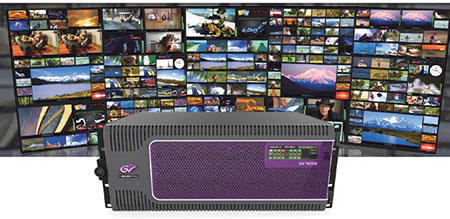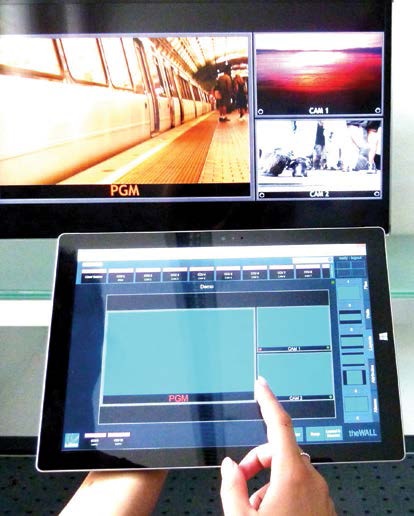Multiviewers Hook Up With a Hybrid World
HAMILTON, N.J.—Multiviewers have long been essential for displaying a mosaic of different video sources on a single display device during live production, and for confidence monitoring in a network operation center, among other applications.
But as the broadcast industry transitions from SDI to IP, and resolutions climb to 4K/UHD and beyond, mixing and matching these disparate new formats and standards for display on a single screen poses a technical challenge.
BOLD NEW WORLD
As with our industry’s previous technology shifts—from analog to digital and SD to HD—the migration from HD to UHD and SDI to IP is gradual. During this hybrid phase, Apantac President Thomas Tang says that broadcasters need to ask themselves where they are in this transition before investing in new multiviewers.
“Some broadcasters may be ready to go IP in a big way,” Tang said. “If they’re rebuilding their plant or replacing legacy gear for future-proof solutions, we’re capable of mixing and matching everything they want on a single multiviewer platform right now, including 2022-6, composite video, H.264, 4KUHD, HDMI and more, with our T# [pronounced T Sharp] multiviewer line. But if they feel their future plans are uncertain, or that they’d prefer to wait for the many new IP standards to fully settle down before they commit to a large purchase, our new Mi-16 is a low-cost, transitional solution that will buy them some extra capacity and time.”
Mi-16 handles 16x1 SD/HD/3G signals for under $2,500 and can be easily upgraded to 16x2. And, for those with a few available slots on their Open Gear frames, Apantac also makes economical CVBS/SD/HD/3G and 4K UHD-capable Open Gear multiviewer cards.
When it comes to mixing and matching different formats, multiviewers must first scale them to a common format for processing, such as SDI or 2022-6—which was designed to transport high bit-rate media over IP—and then output them to formats like HDMI, DVI or SDI for output to the display device.
According to Tang, the T#’s universal input module performs input, scaling and mixing of signals as an integrated part of the multiviewer platform, rather than relying on outboard converter boxes. “Whenever you involve external converters, there is an extra layer of ‘finger pointing,’” Tang said, “And if something goes wrong, you’re left determining who or what is responsible.” Developed within the last two years, the T#’s architecture is designed to handle new and emerging standards.
Get the TV Tech Newsletter
The professional video industry's #1 source for news, trends and product and tech information. Sign up below.
MONITORING BY EXCEPTION
With several multiviewers capable of mixing native 4K UHD, uncompressed IP and SDI/baseband within the frame, U.K.-based Snell Advanced Media custom-tailors configurations to the unique needs of broadcasters migrating from SDI to IP. “Our technology gives broadcasters the flexibility to work the way they want today, yet future-proof their operations for the way they envision working in the future,” said Peter Timmons, multiviewer product manager for SAM.
For those that prefer baseband, SAM’s multiviewer solutions support 4K as well as IP. SAM’s MV800 is based on 48x12 I/O multiviewer cards that reside in dedicated MV slots of SAM’s Sirius 800 router frame for integrated operation. In the future, SAM plans to support 12G for customers who prefer baseband to IP.
For those considering a greenfield IP site, SAM will soon launch an IP multiviewer based on MV800 technology with support for 2022-6, TR-03, VC2 and other uncompressed IP standards. And, for hybrid facilities, SAM has multiviewers that accept both baseband and IP streams and convert them within the frame.
At the 2016 IBC Show, SAM will introduce MV800 Desktop, offering H.264 compressed versions of the MV800’s inputs, enabling people to do remote confidence monitoring from their desktops. SAM will also debut a software-based IP multiviewer.
Timmons said that SAM’s solutions combine control and monitoring workflow schematics with multiviewer video presentations to alert operators to potential problems.
CONVERTING TO 2022-6
The plethora of new video standards is one of the main challenges in multiviewer technology today, according to Ketan Patel, multiviewer product manager for Evertz in Burlington, Ont. “Our MVP signal monitoring platform has long allowed a mix of signals, such as analog, SD, HD, 3G, HDMI and IP [MPEG-2, H.264 and JPEG2000], on a single display,” he said. “For customers moving towards an all-IP or UHD facility in the future, our newest platform 3067VIP series is ready for it.”
The 3067VIP series platform monitors SMPTE RDD 37 (ASPEN), VSF TR03, SMPTE 2022-6, JPEG2000, in addition to traditional HD/3G-SDI input or via XLINK technology.
“With 4K, 12G, HDR and different IP formats, multiviewers need to be flexible to support future customer needs,” Patel said.
In the two years since Evertz introduced the 3067VIP, Patel said that it’s been installed in more than 50 OB trucks and broadcast facilities worldwide. Generation operational management and orchestration platform.
Consistent with Imagine's mission to facilitate a seamless transition to an all-IP future, EPIC MV is a hybrid SDI/IP solution that’s also UHD ready. It supports SMPTE 2022- 6 and 2022-7 standards for video over IP, and SMPTE 2022-2 for compressed delivery over IP, with other new standards being added as they’re adopted.
Imagine’s Zenium workflow management platform provides the framework for the software-based, UHD-ready IP multiviewer, according to Robert Millis, senior product manager for Imagine Communications. “With Zenium, we have a growing suite of software components capable of doing innovative processing tasks, from unwrapping and decoding different formats, to video processing and presentation,” he said. “When higher performance is needed, Zenium easily allows you to add hardware acceleration to optimize demanding workflows. Zenium also provides the infrastructure to scale EPIC MV across many hardware nodes, providing a solution for any size monitoring need.”
EPIC MV was designed for high-value live production, including challenging mobile environments, where the rigors of travel and event setup come into play. Its rich toolset lets users dynamically change the views on the monitor walls. And it minimizes noise emission, with efficient power consumption.
While EPIC MV helps facilitate the transition from SDI to IP with UHD display support, Millis said, “it still offers HD/SD-3G support over BNC and baseband, hooks to legacy interfaces, and handles today’s standards and formats, all on the same framework.”

Grass Valley’s KMX-4911 Kaleido Multiviewer, which enables customers to input, monitor and output a wide range of HD and SD formats as well as new standards. Each KMX-4911 card fits into a slot on the GV Node frame, Grass Valley’s flagship real-time IP processing and routing platform.STRONG IP BACKBONE
Grass Valley recently launched the KMX- 4911 Kaleido Multiviewer, which enables customers to input, monitor and output a wide range of HD and SD formats as well as new standards, such as SMPTE 2022-6, TICO compression for 4K UHD over IP, and 4K inputs paired with 4K UHD display outputs for live productions.
Each KMX-4911 card fits into a slot on the GV Node frame, Grass Valley’s flagship real-time IP processing and routing platform. While GV Node itself supports frame-accurate Densité signal processing and routing across the broadcast workflow, the KMX- 4911 cards specifically add Kaleido multiviewing of all major SD and HD formats, input of IP signals, as well as monitoring of 4K UHD sources on a 4K display.
Since GV Node is modular, “it can be reconfigured by adding or swapping cards, making it easy for users to integrate and display the video formats their facilities need now and in the future for live production, playout, and master control, mobile broadcast or other applications,” said Martin Jolicoeur, multiviewer product manager for Grass Valley. Each GV Node frame includes 12 built-in 40 GigE ports, and each KMX- 4911 module scales from 9–36 inputs and from one to four outputs.
“At its core, our GV Node has an IP infrastructure capable of accurate, deterministic switching,” Jolicoeur said. “In large multiviewer installations of about 20 or more displays, this IP core optimizes performance and saves money by eliminating costly, complex cabling between the router and multiviewer.”

Lawo’s “theWall” software provides a touchscreen-optimized HTML5 GUI, allowing easy multiviewer set-up using the browser of any device, such as an iPad.INTERACTIVE SET-UP
Lawo, a German-based provider of IP technology for media enterprises, has developed an intuitive, interactive application that simplifies set-up and control of multiviewers and monitor walls, including routing signals, changing mosaic layouts or saving and loading user presets. While today’s multiviewers have complex software configuration panels, Lawo’s “theWall” software provides a touchscreen-optimized HTML5 GUI, allowing easy multiviewer set-up using the browser of any device, such as an iPad.
Based on touchscreen input, theWall acts as a go-between, sending whatever technical commands are needed to configure the desired display. The user experience remains consistent regardless of the multiviewer’s brand, size or features, and users are no longer dependent upon others with specialized expertise. theWall supports Imagine and Cobalt multiviewers; control of Evertz, Grass Valley and other brands is in development.
“theWall is especially beneficial on OB trucks, where freelancers, such as TDs or producers, want to custom-tailor monitor walls for live shows,” said Erling Hedkvist, senior vice president, Americas for Lawo. “This request typically requires the engineer-in-charge—often the busiest person on the truck compound— to spend valuable time configuring the multiviewer, or the crew must settle for a preconfigured layout that’s not ideal for their show.”
This affordable IP-driven control system also benefits busy studios, where different shows are produced back to back. Users can easily store setups to return any multiviewer to preferred settings.
“With theWall, any production team member can achieve more pleasing, creative display configurations and workflows on their own than would otherwise be possible,” Hedkvist said. theWall, which Lawo acquired from NEP, is part of Lawo’s VSM vendor independent control and monitoring platform, which controls a multitude of routers, switchers, graphics systems and other devices into one unified workflow.
Cobalt Digital offers the 9970-QS openGear card form factor and BBG-1070- QS standalone multiviewers for traditional broadcast and broadcast, according to Bob McAlpine, executive vice president of sales and marketing for Cobalt. “The combination of Cobalt’s award-winning signal monitoring and image processing knowledge, along with the density of the 9970-QS openGear card and flexibility of the BBG-1000 have proven to be tough to beat,” he said.
The 3G/HD/SD/SD-SDI/CVBS 5 Input “quint-split” display processors offer five auto-detect inputs to one display and use a cascading system architecture when more source images are required on a display. Some new enhancements include Dashboard control GUI optimizations that make setting up even a large cascade system an easy task, as well as the ability to capture full 1080p still images of the multiviewer output for remote viewing over IP in DashBoard of Web-GUI.

